For many, the use of Microsoft Teams has become quite chaotic – way too many teams, channels and group chats and documents in a total mess. This chaotic way of working leads to frustration and dissatisfaction with the tool itself. As always, it’s about how we use the digital tools. To work effectively in Microsoft Teams requires structure. Users need to know which team is used for what, which channels we use to communicate, how group chats should only be used for things that are time-critical or more socially related, and how to find specific documents.
So where do you start to create a sustainable structure in Teams? The key to success is to implement a Teams Strategy. In this blog, you’ll get some good recommendations on how to create a Team Strategy for your organization.
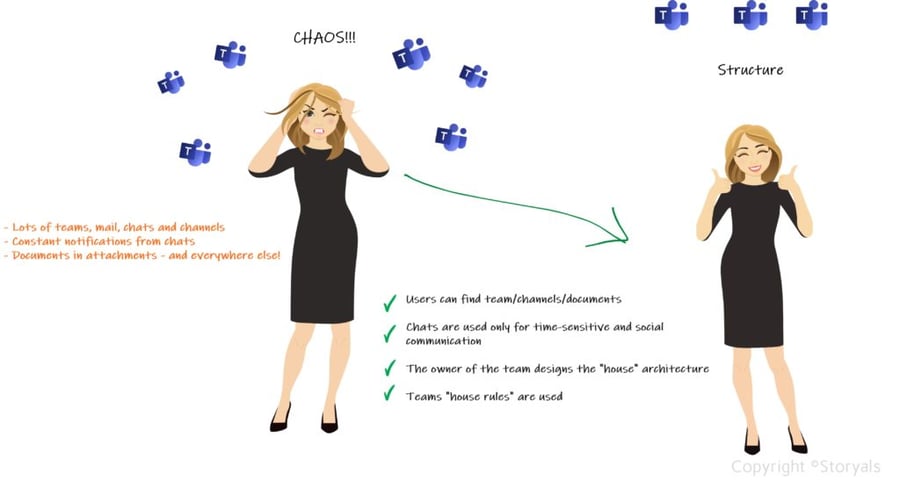
Implement a Teams Strategy
What is a Teams Strategy anyway? Well, let’s start by defining what it is not. It isn’t to roll out Microsoft Teams to everyone and let your employees run free without any guidelines.
That way you are guaranteed chaos. No one takes responsibility for developing guidelines, no one reviews what training might be needed and what requirements should be in place for end-users. No one follows up on, or takes into account, the frequent updates and changes Microsoft is introducing. So to develop a Teams Strategy, we recommend the following:
1. Define what Microsoft Teams should be used for
It’s important that you as an organization make an active decision and define what you will use Teams for. Should it be used only for chat and online meetings? Or should it be used in full capacity, for collaboration and access to other business systems? That decision is naturally linked to a variety of factors – such as which other systems are used within the organization, what the business model looks like, the end-users maturity level when it comes to digital skills, etc. This decision can be adapted to fit better with different parts of the organization, as well as change over time.
Make sure you build in some flexibility for how you make use of Teams. All of a sudden, Teams adds on new functions, which partially or fully replace things like the phone, intranet, project technology, or integration with another important system, such as logistics or CRM.
2. Develop different types of teams
At Storyals, we are often asked if organizations should build teams in a hierarchy, or in a process-based structure. The answer is both. We need to work together with people in our own team and department, as well as across departments in various projects and processes.
We can also have other types of teams, for specific offices, projects or why not a special interest such as “The Cycling Fans”. Having said that, it’s important to point out that collaboration in Microsoft Teams is about creating a better digital work environment for our everyday activities and building relationships with colleagues – not only for social relationships and interests.
One of these days, we might have good templates from Microsoft on how to add certain content in our teams – but we’re just not there yet. Right now, we have to work with best practices, role models and concepts.
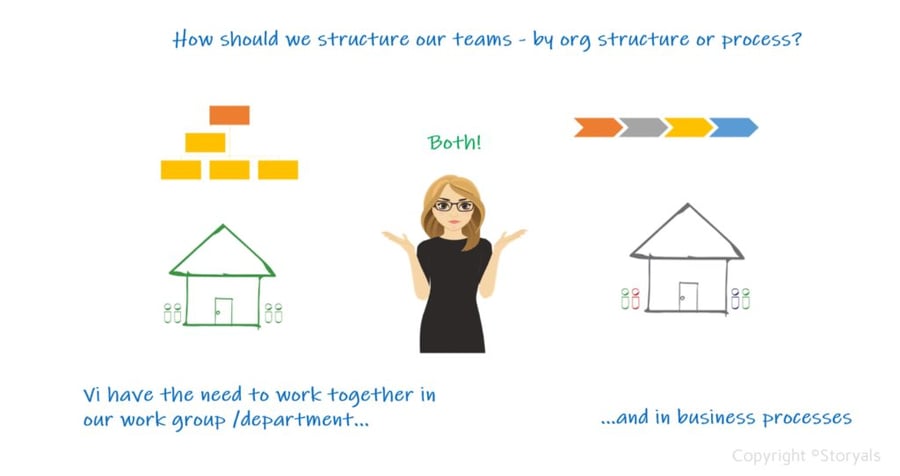
3. Create a policy for how to set up teams
At Storyals, we work with the analogy that a team is like a house. If we all could just build houses wherever we wanted, and in any size, shape or form, there would be nothing but chaos.
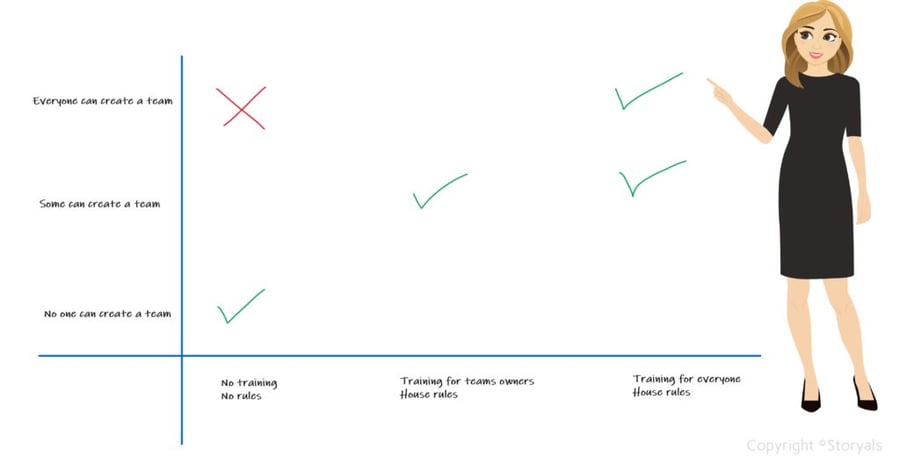
Adopt the same thinking when it comes to setting up new teams. Create a policy for setup of new teams in your organization.
There are certain things the creator of a team needs to consider. What’s the purpose of the team? Should it be public or private? Who should be added as an additional owner? Should members be added manually one by one, or via a group created by the IT department? Make sure that team creators are trained on these things and feel free to automate the process so it’s easy to do it right. At Storyals, we have the relevant training for working efficiently with Microsoft Teams. Here is also a proposal for a free app that Microsoft has developed to control the creation of teams: Request a Teams app.
4. Implement your own ”Golden Rules”
Teams owners are also information owners. This is a big change from how we are used to work from before, but fact is, that whoever owns the team and the collaboration, also owns the information. The IT department does not own the information just because the manage the technology. The teams’ owner is responsible for having the right people in the team, that the information is shared correctly and that it doesn’t leak to anyone outside the team.
There must be AT LEAST two owners for each team! You can have more, but we should never ever depend on just one person to be responsible for the team. This person could suddenly resign or be on vacation and then you’re not able to quickly add members or manage the team.
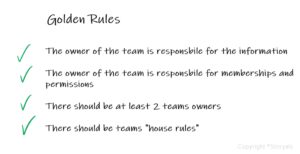
There should be “house rules” for how to work in each team. However, you don’t have to work the same in all houses. The Marketing department will never work in the same way as Finance, but all houses (or teams if you like) must have house rules.
Download our template to get started with your own house rules. We have added some suggestions for common house rules in there. Place the responsibility on your team owners to create the rules needed in their specific team.
5. Let the teams’ owner design the team (the house) and give adequate guidance
Some things come by default when you set up Microsoft Teams. For example, all teams get a channel called “General” (which can’t be renamed). In our analogy of the house, the channels can be seen as “rooms” in the house, where you work together with colleagues. The channels must therefore be created based on what type of job will be performed.
Provide adequate guidance for which channels are necessary – for example a channel for social small talk (“by the coffee machine”), a private channel for management, etc. To guide the end-users, we recommend using the channel tabs to clarify the purpose of that specific channel. The tab should include the following: Purpose, Target group, Working methods and Owner. Make sure all your public teams have this and lead by example.
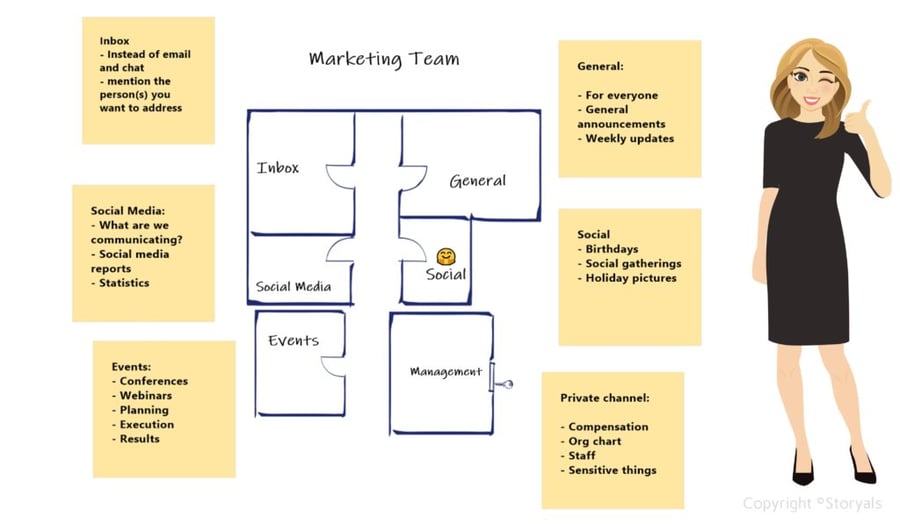
Do you need help creating teams? Contact us and we will help your management team, marketing department, etc create teams. We have a great online workshop where we go through everything and help you create a Team Structure that fits your organization.
6. Create archives and require team owners to clean up
Archiving is the solution to Teams not becoming the G: / of the future – a cemetery of collaborations from the past. The most important aspect here is that information ownership is transferred from the manager to legal, archivist or management, all depending on how your organization is structured.
What should be archived?
- Anything strategically important
- Anything GDPR sensitive
- Everything that must be saved
- Everything that wants to be saved
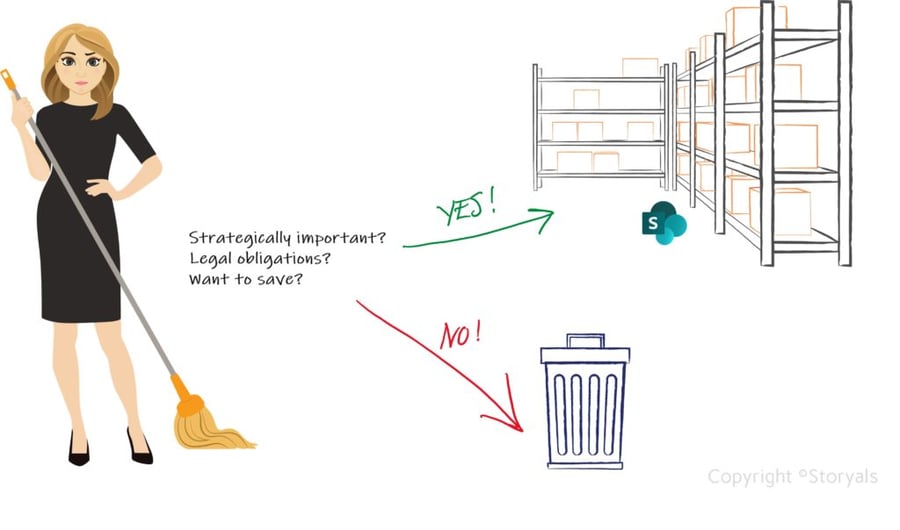
This should not be an individual evaluation from the team owners, but jointly defined by the organization, via the information owner of the archive, or the archives (you can have several archives, such as HR archives, finance archives, project archives, etc).
It is possible to “archive” teams technically as a Microsoft Teams Administrator. However, it isn’t recommended since it only removes the team and all the communication from Microsoft Teams. Nothing is done to the actual documents in that team.
Finally, setting up archives is not something you do in the blink of an eye. But it is important to keep everything in order to avoid utter chaos.
Contact us or book an Information & Document Management Workshop to take your next step!
